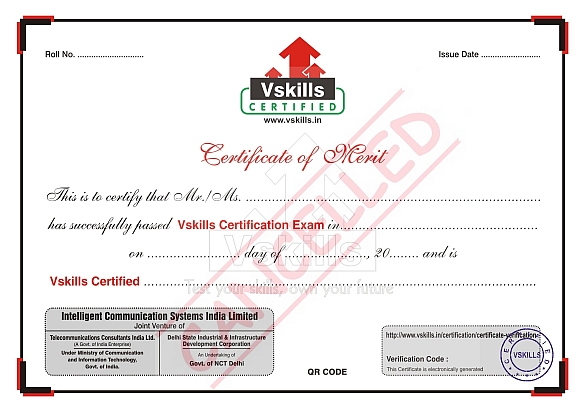- Duration / Course length: 1 To 2 Months Start now
- Certificates:
- Course delivery: This course is delivered in video format
Course details
Vskills certification for Cordova Developer assesses the candidate as per the company’s need for developing mobile applications which work in different mobile operating system. The certification tests the candidates on various areas in Cordova based mobile application basics, using the command-line interface, Using Cordova with iOS, Blackberry, Android or Windows Phone, file, plug-in development and whitelisting.Why should one take this certification?
This Course is intended for professionals and graduates wanting to excel in their chosen areas. It is also well suited for those who are already working and would like to take certification for further career progression.
Earning Vskills Cordova Developer Certification can help candidate differentiate in today's competitive job market, broaden their employment opportunities by displaying their advanced skills, and result in higher earning potential.
Who will benefit from taking this certification?
Job seekers looking to find employment in mobile application development departments of various companies, students generally wanting to improve their skill set and make their CV stronger and existing employees looking for a better role can prove their employers the value of their skills through this certification.
Table of Contents
Overview
- Basic Components
- Development Paths
- Installing Cordova
- Platform Support
- Cordova Applications
- Prerequisites
- Installing the Cordova CLI
- Create the App
- Add Platforms
- Build the App
- Test the App on an Emulator or Device
- Add Plugin Features
- Advanced Plugin Options
- Using merges to Customize Each Platform
- Help Commands
- Updating Cordova and Your Project
- Android
- BlackBerry 10
- iOS
- Windows Phone 8
- Windows
- Installing Plugman
- Create a Cordova Project
- Remove a Plugin
- Help Commands
- Registry Actions
- Installing Core Plugins
- Core Configuration Elements
- Global Preferences
- Multi-Platform Preferences
- The feature Element
- The platform Element
- Configuring Icons in the CLI
- Example configuration
- Supported platforms
- Splashscreen Plugin
- Amazon Fire OS WebViews
- Android WebViews
- iOS WebViews
- Using CDVViewController
- Adding HTML, CSS and JavaScript Assets
- Windows Phone WebViews
- Building a Plugin
- Validating a Plugin
- The JavaScript Interface
- Sample JavaScript
- Native Interfaces
- Publishing Plugins
- Privacy
- Collection of sensitive information
- Third party data collection or sharing
- Collection limitation and security
- Guidelines
- Notice & Transparency
- Control & Choice
- Data Retention & Security
- Accountability
- Whitelist
- Iframes and the Callback Id Mechanism
- Certificate Pinning
- Self-signed Certificates
- Encrypted storage
- Amazon Fire OS Whitelisting
- Android Whitelisting
- iOS Whitelisting
- BlackBerry 10 Whitelisting
- Firefox OS
- Windows Phone Whitelisting
- Tizen Whitelisting
- cordova-plugin-whitelist
- LocalStorage
- WebSQL
- Plugin-Based Options
- Best Practices
- Handling Upgrades
- Testing
- Debugging
- User Interface
- Special Considerations





